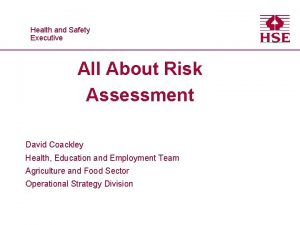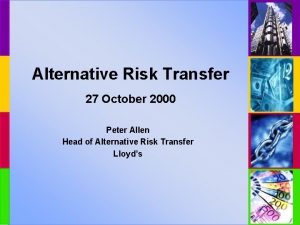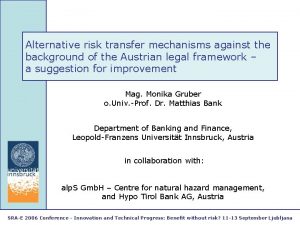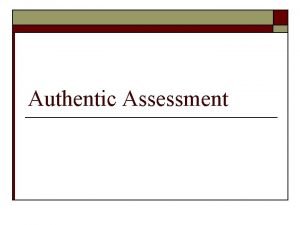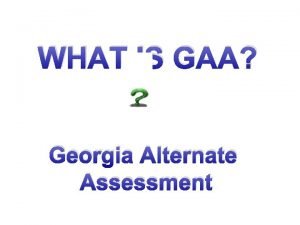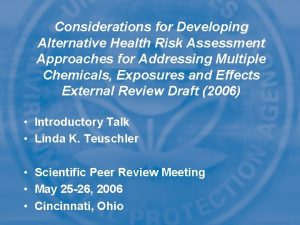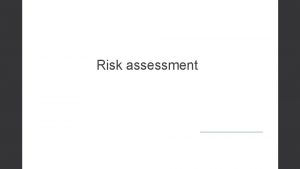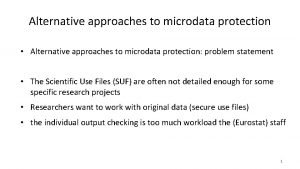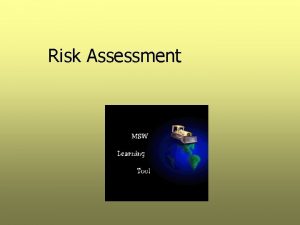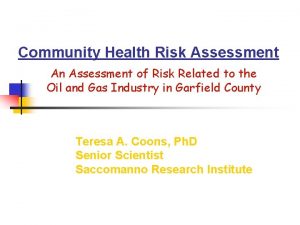Considerations for Developing Alternative Health Risk Assessment Approaches










- Slides: 10

Considerations for Developing Alternative Health Risk Assessment Approaches for Addressing Multiple Chemicals, Exposures and Effects External Review Draft (2006) • Introductory Talk • Linda K. Teuschler • Scientific Peer Review Meeting • May 25 -26, 2006 • Cincinnati, Ohio

Authors • U. S. EPA, Office of Research and Development, National Center for Environmental Assessment Cincinnati, OH Richard C. Hertzberg (Retired) John C. Lipscomb Glenn E. Rice Linda K. Teuschler • U. S. Department of Energy, Argonne National Laboratory, Argonne, IL Margaret Mac. Donell James Butler Young-Soo Chang Heidi Hartmann John Peterson Kurt Picel • Tetra Tech EM, Inc. , Dallas, TX Shanna Collie Alan Johns Shannon Garcia Camarie Perry • ENVIRON Corporation, Emeryville, CA Lynne Haroun

Risk Assessment Guidance for Superfund (1989) Methodology for Multipathway Combustor Emissions (1998) Guidance for Assessing Health Risks of Chemical Mixtures (2000) Guidance on Cumulative Risk of Pesticides (2002) Planning & Scoping for Cumulative Risk Assessment (1997) Planning & Scoping Lessons Learned (2002) Framework for Cumulative Risk Assessment (2003) Considerations for Developing Alternative Health Risk Assessment Approaches for Addressing Multiple Chemicals, Exposures and Effects (2006) Related EPA Efforts

Definitions from EPA’s 2003 Framework for Cumulative Risk Assessment (EPA/630/P-02/001 F) • Cumulative Risk: The combined risks from aggregate exposures to multiple agents or stressors. • Agents or Stressors: May be chemicals, biological or physical agents, or the absence of a necessity such as habitat. • Cumulative Risk Assessment: An analysis, characterization, and possible quantification of the combined risks to health or the environment from multiple agents or stressors.

Focus of this 2006 “Approaches” Document (EPA/600/R-06/013 A) • Concepts and methods for potential use in the conduct of cumulative risk assessments (This is NOT a regulatory document and is NOT official EPA guidance. ) • Combined human health risks for aggregate exposures to multiple chemicals (Does not address biological or physical stressors. ) • Exposure methods consider multiple pathways, routes, environmental transformations, timeframes. • Toxicity methods consider multiple effects, toxicological interactions. • Identify existing risk assessment guidance, data and risk information for use in assessing multiple exposures, effects and chemicals

Information Gathering & Processing public health data Sources, releases multiplechemical fate Combined characterization Population illness population subgroup features Triggers Data Elements multi-route exposures mixtures toxicity Chemical concentrations

Key Steps in a Cumulative Risk Assessment STEPS 3 1) Identify “Trigger” for CRA 2) Characterize Population based on Trigger 3) Generate Chemical List 4) Identify Links between Chemicals & Subpopulations 5) Quantify Exposure for General Population and Subpopulations 1. 3. 1 SECTION 2. 1 Population Profile 2. 2 List of Chemicals of Concern 2. 3 4 6) Quantify Dose. Response for Initial Toxicity-Based Chemical Grouping 7) Integrate Exposure & Dose Response; Refine Exposure and Toxicity Assessments 8) Conduct Risk Characterization OUTPUTS 3&4 5 Chemical Groups By Media & Time Chemical Groups By Toxicity Integrated Chemical Groups Final Cumulative RA

New & Emerging Approaches • Grouping chemicals for risk assessment based on exposure characteristics and toxic endpoints • Multiple route combinations of Relative Potency Factors • Internal doses to account for multiple route exposures • Integration of categorical regression multiple effects modeling with additivity methods • Interaction-Based Hazard Index • Emphasis on interdependence of toxicity and exposure for assessing risk • Considerations for cumulative risk characterization, using Cumulative Hazard Index as an example • Cumulative Risk Toolbox (Appendix A) of existing information for use in assessing multiple exposures, effects and chemicals

Document Organization: Chapters & Appendices 1 Introduction to Cumulative Risk at the U. S. EPA 2 Initial Characterization of the Population and Chemicals of Concern 3 Cumulative Exposure Assessment 4 Cumulative Toxicity Assessment 5 Cumulative Risk Characterization 6 References 7 Glossary Appendix A: Cumulative Risk Toolbox Appendix B: Toxicity Information to Support Groupings

History & Next Steps • Feb 2001: NCEA began work developing cumulative risk approaches and information through an Interagency Agreement with the Department of Energy • Nov. 2004: Superfund Program Office & Regional Internal EPA Review • March 2006: External Review Draft released for a 45 Day Public Comment Period. • May 2006: Scientific Peer Panel Review • June 2006: Final Report from Peer Panel Review • 2006: Final Draft to be published following changes made in response to internal EPA, public and panel comments.
 Pricing considerations and approaches
Pricing considerations and approaches Null hypothesis vs alternative hypothesis
Null hypothesis vs alternative hypothesis Who engages in channel design
Who engages in channel design Market risk credit risk operational risk
Market risk credit risk operational risk Health and safety risk assessment template
Health and safety risk assessment template Population health risk assessment and management
Population health risk assessment and management Advantages and disadvantages of alternative risk transfer
Advantages and disadvantages of alternative risk transfer Risk transfer mechanisms
Risk transfer mechanisms Authentic task meaning
Authentic task meaning Characteristics of effective tools for evaluation
Characteristics of effective tools for evaluation What is gaa
What is gaa




